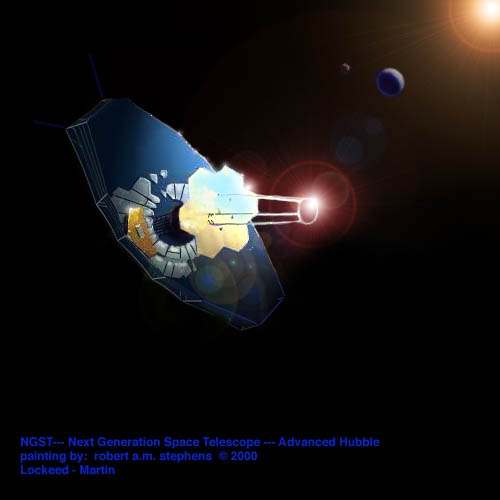- Due for STS launch and orbital insertion
in 2003, the NGST - Next Generation Space Telescope - will be an incredible
40 times more powerful than the current Hubble Space Telescope (HST).
Too, it will see in temperature mode countless objects that have never
been observed before. NGST will also 'see' into the cosmos, and therefore
'time,' in values never imagined.
-
-
-

-
-
-
- NGST will be the Rosetta Stone for discovering
and seeing what objects lay out in the super cold regions of our sun's
influence and sphere of gravitational hold - areas roughly 20+ billion
miles from Sol itself. There have been hints that large objects are out
there the size of Jupiter, and possible greater, but it has been impossible
to image these unknowns since they emit no light. However, their apparent
and real temperatures will allow for registration with NGST. From that
point, NGST will be able to form digital images from the signatures of
these distant and suspected objects.
-
- The peculair gravitational fluxes observed
in all orbital bodies that swing around our sun have been theoretically
attributed to these large, unknown trans-solar objects, but this has never
been conclusively defined. NGST will render this mystery moot.
-
- Current HST capability can resolve objects
400 miles in diamter on planet Pluto and its linked moon Charon, the warmest
moon in our solar system. NGST will resolve objects on Pluto down to 19
miles. To make a comparison closer to home: NGST, if it were possible,
would be able to image birds flying around the World Trade Center from
Hawaii.
-
- NGST will also look 'back in time' with
arrays never before available for picking out the faintest of objects at
the very end of known distances from us. It is assumed NGST will allow
us as a species to see back 25 billion years or more, basically to the
beginning of time...to the very edge of the universe as it is known.
-
- It is the boldest step yet for man to
try to see where we have come from, and possibly by conditions found in
our own galaxy and others nearby, to learn where we are heading.
-
- NGST is tentatively scheduled for high
Earth Orbital insertion via STS in late 2003.
|